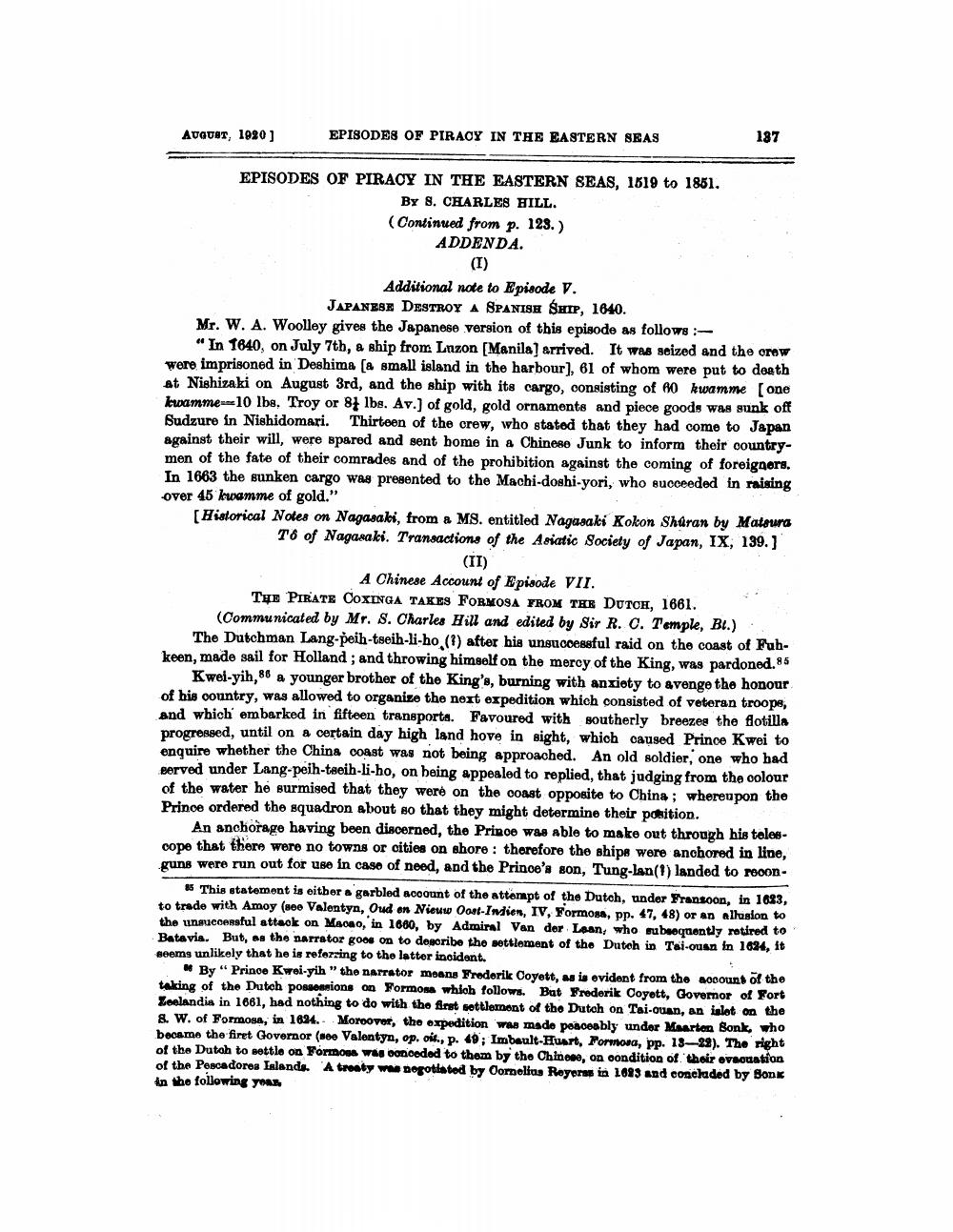________________
AUGUST, 1990)
EPISODES OF PIRACY IN THE EASTERN SEAS
187
EPISODES OF PIRACY IN THE EASTERN SEAS, 1819 to 1881.
By S. CHARLES HILL. (Continued from p. 123.)
ADDENDA.
Additional note to Episode V.
JAPANESE DESTROY A SPANISH SHIP, 1840. Mr. W. A. Woolley gives the Japanese version of this episode as follows:
"In 1640, on July 7th, a ship from: Luzon (Manila) arrived. It was seized and the crew were imprisoned in Deshima (a small island in the harbour), 61 of whom were put to death at Nishizaki on August 3rd, and the ship with its cargo, consisting of 60 kwamme (one kwamme-10 lbs, Troy or 87 lbs. Av.] of gold, gold ornaments and piece goods was sunk off Sudzure in Nishidomari. Thirteen of the crew, who stated that they had come to Japan against their will, were spared and sent home in a Chinese Junk to inform their countrymen of the fate of their comrades and of the prohibition against the coming of foreigners. In 1663 the sunken cargo was presented to the Machi-doshi-yori, who succeeded in raising over 45 kwamme of gold." [Historical Notes on Nagasaki, from a MS. entitled Nagasaki Kokon Shuran by Matsura
T6 of Nagasaki. Transactions of the Asiatic Society of Japan, IX, 139.)
(II)
A Chinese Account of Episode VII. THE PIRATE COXINGA TAKES FORMOSA FROM THE DUTCH, 1661. (Communicated by Mr. 8. Charles Hill and edited by Sir R. O. Temple, Bl.)
The Dutchman Lang-peih-tseih-li-ho (1) after his unsuccessful raid on the coast of Fuhkeen, made sail for Holland, and throwing himself on the mercy of the King, was pardoned.es
Kwei-yih, 86 a younger brother of the King's, burning with anxiety to avenge the honour of his country, was allowed to organize the next expedition which consisted of veteran troops, and which embarked in fifteen transporta. Favoured with southerly breezeg the flotilla progressed, until on a certain day high land hove in sight, which caused Prince Kwei to enquire whether the China coast was not being approached. An old soldier, one who had Berved under Lang-peih-taeih-li-ho, on being appealed to replied, that judging from the oolour of the water he surmised that they were on the coast opposite to China ; whereupon the Prince ordered the squadron about so that they might determine their position.
An anchorage having been discerned, the Prince was able to make out through his talescope that there were no towns or cities on shore : therefore the ships were anchored in line, guns were run out for use in case of need, and the Prince's son, Tung-lan(1) landed to rooon
* This statement is either a garbled account of the attempt of the Dutch, under Fransoon, in 1693, to trade with Amoy (
ne Valentyn, Oud en Nieuw Oost-Indien, IV, Formosa, pp. 47, 48) or an allusion to the unsuccessful attack on Maono, in 1660, by Admiral Van der Laan, who rubroqnently retired to Batavia. But, as the narrator gooi on to describe the settlement of the Dutch in Tai-ousn in 1624, it seems unlikely that he is referring to the latter incident.
# By "Prince Kwei-yih" the narrator moans Frederik Coyett, as is evident from the account of the taking of the Dutch ponsennions on Formoss which follows. But Frederik Coyott, Governor of Fort Leolandia in 1681, had nothing to do with the first settlement of the Dutch on Tai-ouan, an islet on the & W. of Formosa, in 1824. Moreover, the expedition was made peaceably under Maarten Bonk, who became the firet Governor (nee Valentyn, op. oit., p. 40; Imbault-Huart, Formosa, pp. 18-28). The right of the Dutoh to settle on Formoss was conceded to them by the Chinese, on oondition of their eviouation of the Pescadores Inlande. A treaty w pogotiated by Oornelias Royers in 2013 and concladed by Bonk in the following you




